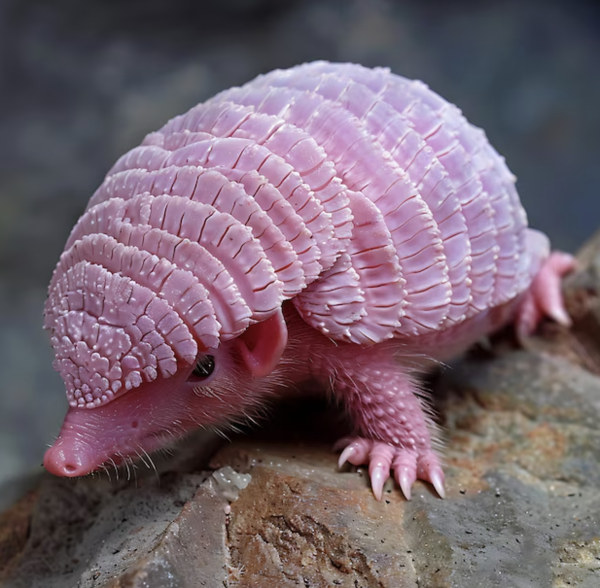Armadillos are fascinating creatures, known for their hard, protective armor and unique behaviors. Among the various species, some are small enough to fit in the palm of your hand. If you’ve ever wondered which is the smallest armadillo in the world, you're in for a surprising discovery! In this article, we'll explore the smallest armadillo species, their physical traits, habitat, diet, and more.

The title of smallest armadillo goes to the Pink Fairy Armadillo (Chlamyphorus truncatus). This tiny armadillo is found primarily in central Argentina and is known for its incredibly small size and distinctive appearance.
Size: The smallest armadillo can measure only about 5 to 6 inches (12 to 15 cm) in length. In comparison to other armadillo species, which can reach sizes over 2 feet, the Pink Fairy Armadillo is truly miniature.
Weight: It weighs only around 3.5 to 4.5 ounces (100 to 130 grams). Its small body makes it one of the lightest species in the armadillo family.
Appearance: The Pink Fairy Armadillo is named for its soft, pink-colored shell, which covers only part of its body. The rest is covered in soft fur, which helps it blend into its sandy desert habitat.
The smallest armadillo, the Pink Fairy Armadillo, is native to the central and northern regions of Argentina. These creatures tend to live in arid, sandy areas and are well-suited for burrowing. They are typically found in regions where they can dig easily and find food underground.
Deserts and Semi-arid Zones: The smallest armadillo enjoys dry, sandy environments. It digs tunnels to escape the heat and find food.
Underground Dwellers: Known for their digging abilities, these armadillos spend much of their lives underground, emerging mostly at night to feed.
The smallest armadillo is an insectivore, which means its diet consists mainly of insects and other small invertebrates. It uses its sharp claws and strong front limbs to dig into the ground and search for food.
Primary Diet: Insects, larvae, ants, and beetles.
Feeding Habits: It is known for its ability to dig quickly, using its strong claws to burrow into the sand in search of food.
Despite its small size, the smallest armadillo has unique and fascinating behaviors. Its life is centered around digging and burrowing, which helps it find food and avoid predators.
Like many armadillo species, the Pink Fairy Armadillo is nocturnal. It prefers to come out during the cooler hours of the night to avoid the harsh heat of the daytime.
The smallest armadillo is a solitary creature. It doesn’t live in groups but instead spends its time alone, digging burrows and foraging for food.
Unfortunately, the smallest armadillo is listed as near-threatened due to habitat loss, human encroachment, and climate change. The expansion of agriculture and urbanization in Argentina has resulted in the destruction of the armadillo’s natural habitat, leaving fewer places for it to live and hunt.
Habitat Destruction: The smallest armadillo’s natural environment is being destroyed due to agriculture and urban development.
Climate Change: Changes in temperature and weather patterns affect their ability to survive in desert habitats.
Predation: Larger predators may pose a threat to this tiny armadillo, although it spends most of its life underground, where it is safer.
Speedy Digging: Despite its size, the Pink Fairy Armadillo is an excellent digger. It can create burrows quickly to escape from predators or find food.
Pink Armor: The unique pink color of the smallest armadillo’s armor is due to the thin layer of keratin that protects its body. Unlike other armadillos, this pink-colored armor is soft and flexible, allowing for greater mobility.
Rarely Seen: Because of its nocturnal and burrowing nature, the Pink Fairy Armadillo is rarely seen by humans in the wild.
The smallest armadillo plays a crucial role in its ecosystem by controlling insect populations. By digging and feeding on insects, it helps maintain the balance of the food chain in its desert habitat.
Insect Control: As an insectivore, it helps keep insect populations in check, preventing them from overrunning the ecosystem.
Soil Aeration: Through its digging behavior, the smallest armadillo also helps aerate the soil, which benefits plant life in the desert.
To ensure the survival of the smallest armadillo, conservation efforts are necessary to protect its natural habitat and address the threats it faces. This can include:
Habitat Conservation: Protecting the desert areas of Argentina where these armadillos live.
Climate Action: Mitigating climate change to prevent further disruption of the armadillo's habitat.
Awareness and Education: Educating local communities about the importance of preserving the smallest armadillo and its role in the ecosystem.
The smallest armadillo, the Pink Fairy Armadillo, is a remarkable creature that captivates with its tiny size and unique characteristics. Despite its small stature, it plays a vital role in the ecosystem and faces significant conservation challenges. By learning more about this fascinating species and supporting conservation efforts, we can help ensure that the smallest armadillo continues to thrive in its natural habitat.
animal tags: smallest-armadillo
We created this article in conjunction with AI technology, then made sure it was fact-checked and edited by a Animals Top editor.